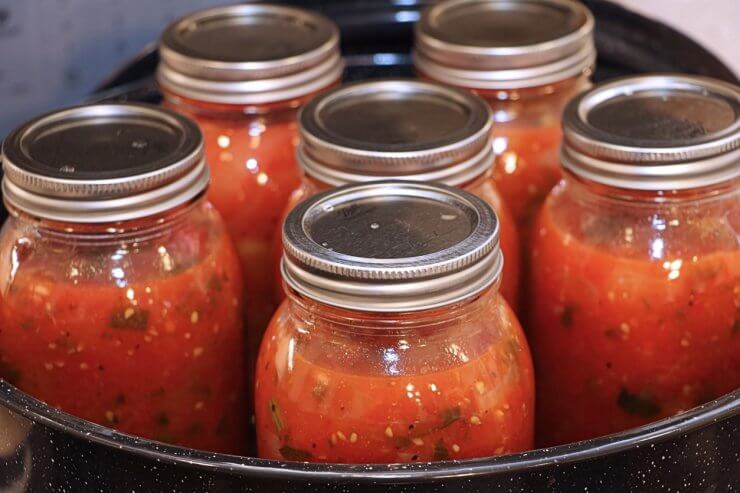
Canned tomatoes
So, you’ve picked plenty of tomatoes and you have more than you can eat in a week. Time to put together a preservation plan!
Freezing
Freezing is one of the quickest and easiest ways to prepare your tomatoes for storage. You can use peeled frozen tomatoes for sauces and soups whenever you like. Put them in different-sized bags or containers so you only defrost what you need.
- Choose perfectly ripe tomatoes. Wash them, remove stems, and boil them.
- Cool, drain, and peel the skins off. Pack in airtight bags, leaving 1/2 inch of headspace. Store flat in the freezer
If you have a vacuum food sealer, use it to prevent freezer burn and extend the storage life of your tomato crop.
Canning
Canning is a time-honored preservation method—and one you should only pursue if you have the right equipment. You must be careful to follow all canning directions to the letter in order to avoid botulism in your canned goods. We have a post in Food Gardening Daily that provides 10 rules to live by for pressure canning safety.
Tomatoes don’t have a long shelf-life, and when you have a billion pounds of tomatoes that come in all at once, you have to do something with them!
Ripe tomatoes will last 12 to 18 months canned. There are jellies, sauces and salsas, stewed tomatoes, crushed tomatoes, and tomato soups! Whatever you do, follow the instructions exactly on your tomato canning recipes, as tomatoes need tried-and-true canning techniques to stay safe to eat over long periods. For all canned foods, store jars at 50 to 70 degrees F and never above 95 degrees F.
Canned foods last a long time as long as they’re canned appropriately. Follow the tips below, but also make sure you’re following specific time-tested recipes for all of your canned foods, like the ones you can get from the manufacturer or Ball jars.
- Use the right sterile supplies. When storing food without refrigeration via the canning method, only use cans, lids, and materials that are intended for canning vegetables. Be sure they are clean and sterile before and during use.
- Read your canning instructions carefully. Follow instructions that come with your canning tools. Use proven recipes and don’t deviate from them. The USDA has an extensive Complete Guide to Home Canning covering everything from tomatoes to vegetables to fruits and even meats and seafood. There is a lot of information in the guide that’s well worth looking through if you’re thinking about canning.
- Use additives like lemon juice or citric acid. Adding lemon juice or citric acid will increase the acidity in your jars, which will make them safer for longer-term storage. As previously stated, you should always follow reputable canning recipes.
Dehydration
You can also dehydrate your harvested tomatoes. Lay out your tomatoes evenly and spread them out in a food dehydrator for about eight hours, or on parchment-lined baking sheets for four to 10 hours at your oven’s lowest setting. Store in an airtight jar out of the light.
For another idea, try hanging your tomatoes out to dry, or laying them out in the sun for sun-dried tomatoes!
How do you store your tomatoes for the long-term? Leave a comment and let me know!


 Previous
Previous

